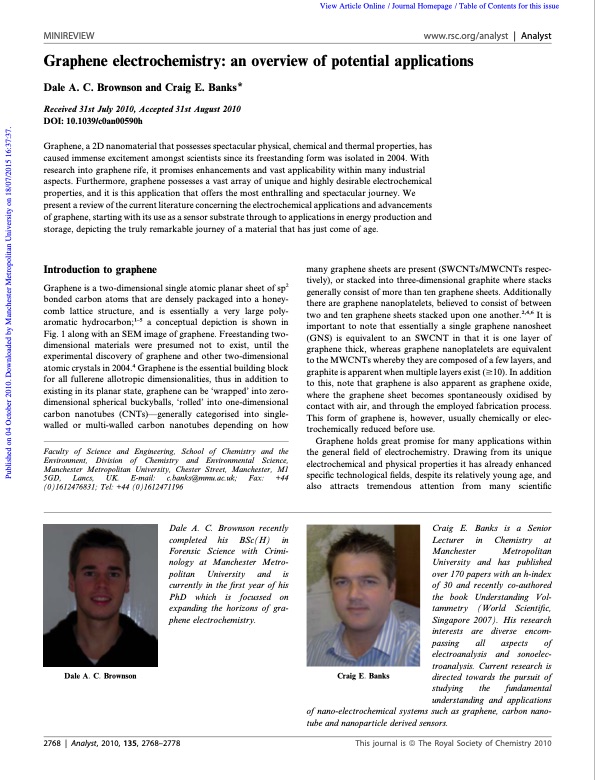
PDF Publication Title:
Text from PDF Page: 002
MINIREVIEW www.rsc.org/analyst | Analyst Graphene electrochemistry: an overview of potential applications Dale A. C. Brownson and Craig E. Banks* Received 31st July 2010, Accepted 31st August 2010 DOI: 10.1039/c0an00590h Graphene, a 2D nanomaterial that possesses spectacular physical, chemical and thermal properties, has caused immense excitement amongst scientists since its freestanding form was isolated in 2004. With research into graphene rife, it promises enhancements and vast applicability within many industrial aspects. Furthermore, graphene possesses a vast array of unique and highly desirable electrochemical properties, and it is this application that offers the most enthralling and spectacular journey. We present a review of the current literature concerning the electrochemical applications and advancements of graphene, starting with its use as a sensor substrate through to applications in energy production and storage, depicting the truly remarkable journey of a material that has just come of age. Introduction to graphene Graphene is a two-dimensional single atomic planar sheet of sp2 bonded carbon atoms that are densely packaged into a honey- comb lattice structure, and is essentially a very large poly- aromatic hydrocarbon;1–5 a conceptual depiction is shown in Fig. 1 along with an SEM image of graphene. Freestanding two- dimensional materials were presumed not to exist, until the experimental discovery of graphene and other two-dimensional atomic crystals in 2004.4 Graphene is the essential building block for all fullerene allotropic dimensionalities, thus in addition to existing in its planar state, graphene can be ‘wrapped’ into zero- dimensional spherical buckyballs, ‘rolled’ into one-dimensional carbon nanotubes (CNTs)—generally categorised into single- walled or multi-walled carbon nanotubes depending on how Faculty of Science and Engineering, School of Chemistry and the Environment, Division of Chemistry and Environmental Science, Manchester Metropolitan University, Chester Street, Manchester, M1 5GD, Lancs, UK. E-mail: c.banks@mmu.ac.uk; Fax: +44 (0)1612476831; Tel: +44 (0)1612471196 Dale A. C. Brownson recently completed his BSc(H) in Forensic Science with Crimi- nology at Manchester Metro- politan University and is currently in the first year of his PhD which is focussed on expanding the horizons of gra- phene electrochemistry. Dale A: C: Brownson many graphene sheets are present (SWCNTs/MWCNTs respec- tively), or stacked into three-dimensional graphite where stacks generally consist of more than ten graphene sheets. Additionally there are graphene nanoplatelets, believed to consist of between two and ten graphene sheets stacked upon one another.2,4,6 It is important to note that essentially a single graphene nanosheet (GNS) is equivalent to an SWCNT in that it is one layer of graphene thick, whereas graphene nanoplatelets are equivalent to the MWCNTs whereby they are composed of a few layers, and graphite is apparent when multiple layers exist ($10). In addition to this, note that graphene is also apparent as graphene oxide, where the graphene sheet becomes spontaneously oxidised by contact with air, and through the employed fabrication process. This form of graphene is, however, usually chemically or elec- trochemically reduced before use. Graphene holds great promise for many applications within the general field of electrochemistry. Drawing from its unique electrochemical and physical properties it has already enhanced specific technological fields, despite its relatively young age, and also attracts tremendous attention from many scientific 2768 | Analyst, 2010, 135, 2768–2778 This journal is a The Royal Society of Chemistry 2010 View Article Online / Journal Homepage / Table of Contents for this issue Craig E: Banks Craig E. Banks is a Senior Lecturer in Chemistry at Manchester Metropolitan University and has published over 170 papers with an h-index of 30 and recently co-authored the book Understanding Vol- tammetry (World Scientific, Singapore 2007). His research interests are diverse encom- passing all aspects of electroanalysis and sonoelec- troanalysis. Current research is directed towards the pursuit of studying the fundamental understanding and applications of nano-electrochemical systems such as graphene, carbon nano- tube and nanoparticle derived sensors. Published on 04 October 2010. Downloaded by Manchester Metropolitan University on 18/07/2015 16:37:37.PDF Image | Graphene Electrochemistry

PDF Search Title:
Graphene ElectrochemistryOriginal File Name Searched:
c0an00590h.pdfDIY PDF Search: Google It | Yahoo | Bing
Salgenx Redox Flow Battery Technology: Power up your energy storage game with Salgenx Salt Water Battery. With its advanced technology, the flow battery provides reliable, scalable, and sustainable energy storage for utility-scale projects. Upgrade to a Salgenx flow battery today and take control of your energy future.
| CONTACT TEL: 608-238-6001 Email: greg@infinityturbine.com | RSS | AMP |